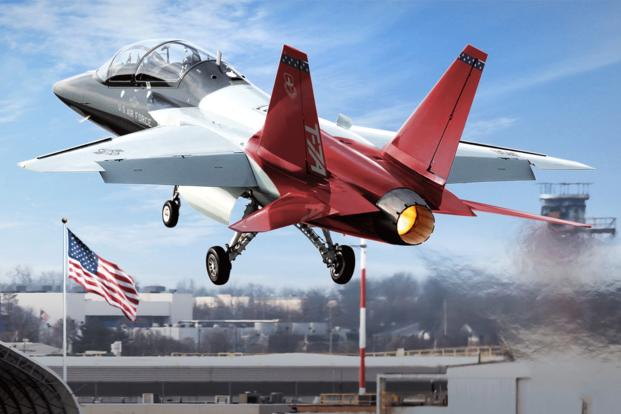Boeing Co. is in discussions to replace the U.S. Navy's aging T-45 Goshawk training aircraft with the company's T-7A Redhawk jet, a top executive said Tuesday.
Chuck Dabundo, vice president and T-7 program manager for Boeing's strike, surveillance and mobility division, told reporters during a virtual event that the company has pitched the T-7's capabilities and how it could help further the Navy's training curriculum.
"There is no program of record right now, [but] I'm hopeful we'll be able to play a role in the Navy's training systems as well," Dabundo said.
Read Next: 10th Mountain Division Leader Responds to Dangerous Army Shoot House Video: 'I Will Fix It'
The U.S. Air Force chose the T-7 program to replace its Northrop Grumman-made T-38 Talon fleet. And there is interest from international customers for T-7 variants, "maybe some with tactical capabilities," Dabundo said.
In September 2018, the Air Force awarded Boeing a $9.2 billion contract to build a replacement aircraft, with a working name of T-X. In 2019, the service rebranded the T-X as the T-7A Redhawk, named in honor of the Tuskegee Airmen. The T-7 is built in partnership with Sweden's Saab.
The first T-7A is expected to be delivered in 2023, along with new flight training simulators. The Air Force has committed to buying 351 T-7A jets, 46 simulators and associated ground equipment.
Dabundo said testing for the T-7 will begin at Edwards Air Force Base, California -- home to the Air Force Test Center -- this summer. The company has built two aircraft to act as test beds for the program. Production will eventually ramp up to about four or five aircraft per month over the first three years of the project, he added.
Last May, the Navy posted an initial solicitation seeking information on a land-based trainer for its Undergraduate Jet Training System program. The service said it needs a two-seater aircraft with ejection seats and a way for pilots to practice carrier landings, according to the solicitation, as reported by FlightGlobal.
However, the Navy does not anticipate procuring a trainer that can conduct arrested landings or catapult launches from aircraft carriers -- a change from its current T-45 fleet, according to the solicitation.
The average age of the Navy's Goshawk aircraft is 20 years, with some of its earliest models dating back to the late 1980s.
In 2017, reports surfaced that about 100 T-45 instructor pilots had refused to fly, citing safety concerns with the aircraft that resulted in pilots experiencing hypoxic-life physiological episodes -- or disorientation -- during flight. Hypoxia-related events have plagued both the T-45 and F/A-18 Super Hornet communities since 2012, according to a 2017 report from Fox News.
The Navy ordered a temporary pause on all T-45 training flights due to the cockpit episodes. After studying the issue, officials in 2020 said they had been able to substantially decrease the number of physiological episodes in the jet despite not finding a root cause for the problem.
Research teams found that T-45 pilots were more likely to experience an oxygen-related incident, whereas F-18 pilots were encountering both pressure change and oxygen anomaly events.
-- Oriana Pawlyk can be reached at oriana.pawlyk@military.com. Follow her on Twitter at @Oriana0214.
Related: Navy Sees Enormous Decrease in Hypoxia-Like Events in its Fighters and Trainers














